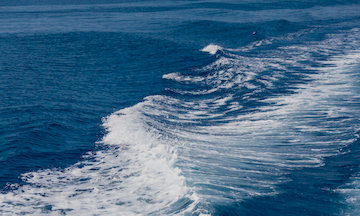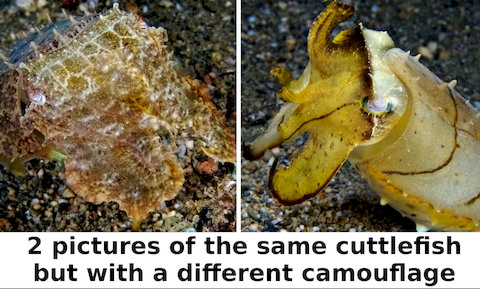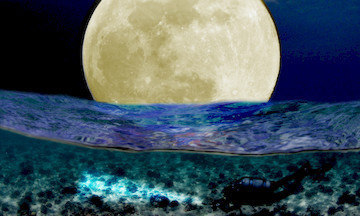Why are the Sky and Sea Blue?
 Haven't you always wondered: Why is the sky blue? Why is the ocean blue? Why can't it be pink or yellow or green? Well, it took centuries to finally answer a simple question.
Haven't you always wondered: Why is the sky blue? Why is the ocean blue? Why can't it be pink or yellow or green? Well, it took centuries to finally answer a simple question.
Our curious minds always tend to ask the most obvious questions, but we often grow up never knowing the real answers.
On this week's "how and why" blog, we will be talking about why the sky and sea are blue; Or is it?
But before getting into the topic of why the sky and sea are blue, we must first understand the science behind how our eyes perceive colors.
When you see a rose, it appears to be pink or red, right? In fact, when you look at your surroundings, you see things appearing in different color. A banana is yellow, those plants are green, the sky is blue, and that building is grey, at least that's how our eyes see it.
How do we see colors?
 First of all, color originates in the light that is absorbed and/or reflected. Light from the sun travels in wavelengths. Light can be absorbed, scattered, reflected, and bent when in contact with matter (solid, liquid, and gas). What we usually see as white light is actually made up of all the colors of the rainbow. When you try holding out a prism glass at the sun or sit a glass of water by the window, the light entering the prism or glass of water bends and reflects out its true colors: red, orange, yellow, green, blue, indigo, and violet.
First of all, color originates in the light that is absorbed and/or reflected. Light from the sun travels in wavelengths. Light can be absorbed, scattered, reflected, and bent when in contact with matter (solid, liquid, and gas). What we usually see as white light is actually made up of all the colors of the rainbow. When you try holding out a prism glass at the sun or sit a glass of water by the window, the light entering the prism or glass of water bends and reflects out its true colors: red, orange, yellow, green, blue, indigo, and violet.
All matter absorbs and reflects light. When light hits, let's say, a leaf, it absorbs all the other colors except green and reflects the color back to our eyes, that's why the leaf appears to be green. That is how everything gets its color; the color is not "in" the matter but how it absorbs and reflects light.
Our eyes have two types of light receptors located at the Retina. Cone cells are responsible for detecting colors, while Rod cells are responsible for dark-adaptive vision at dim light.
What type of primary colors?
 As kids, we were taught of the subtractive primary colors, which are composed of red, blue, and yellow (Cyan, Magenta and Yellow (+the blacK-Key) in printing industry).
As kids, we were taught of the subtractive primary colors, which are composed of red, blue, and yellow (Cyan, Magenta and Yellow (+the blacK-Key) in printing industry).
Subtractive colors are the combination of colors we see that light reflects back to our eyes. When subtractive colors are mixed together, the result ends with a black or darker color. That is why when we paint, the more color we add results to a darker pigment.
Everything we see, if the color is being reflected, that color or combination of colors are subtractive primaries.
The other type is additive primary color. Additive colors is composed of red, blue and green. Additive colors are the combination of colors emitting light to our eyes from screens. Televisions, mobile phones, tablets and computer monitors use the additive color system at each of its tiny pixels. Like the human eye, these devices must also process a large amount of color information at once— on screen. The red, blue and green pixels are so small and tightly packed that the eye’s response is “fooled” into the perception of many different colors when really, there are only three.
So when we are watching the sea and the sky, are we watching them as subtractive or additive colors?
To make it simple, we are watching the blue sky and the blue ocean as subtractive colors.
Is the sky really blue?
When we look up, we are actually looking at Earth's atmosphere. Our planet's atmosphere is mostly made up of nitrogen and oxygen, and these gases are made up of atoms. As stated above, light travels in waves. The warmers tones, like red, travel in longer wavelengths (long, lazy waves), and cooler tones, like blue and violet, travel in shorter wavelengths (small, choppy-like waves). When sunlight passes through nitrogen and oxygen atoms, the atoms cause the light to scatter. The blue wavelength is scattered more than the other colors because it travels at shorter and smaller waves, and is easier to strike atoms. Thus, the sky appears to be blue.
The blue sky is the result of a phenomenon called Rayleigh Scattering. This refers to the selective scattering of the light off of particles that are no bigger than the wavelength of the light. Rayleigh scattering heavily depends on the wavelength of light, with lower wavelength light being scattered most.
Violet is the lowest wavelength light, but why do we see a blue sky and not violet? This is because our human eyes are more sensitive to blue light. Violet light is more absorbed in the upper atmosphere.
During sunset or sunrise, the light from the sun has to pass through more layers of the atmosphere before reaching our eyes. This scatters more blue and violet light, allowing the red and yellow to shine through. That is why the sky appears to be orange, red and sometimes, has the slightest shade of purple in the morning and evening.
Why is the sea blue?
Now, why is the sea blue?
Most people believe the sea or the ocean is blue because it reflects the color of the sky like a mirror, but this is not true.
When you scoop up water from the ocean, it is clear. Yes, a calm sea does reflect the blue sky but the ocean is still blue even when the current is strong and the waves are large.
The ocean appears to be blue because of how it absorbs and reflects light. Water molecules absorb longer wavelengths of light faster easier then on the surface, reflect shorter wavelengths, like the blue wavelength, back to our eyes.
Shallow waters appear to be a lighter shade of blue and sometimes, even green. This is because of the reflected light bouncing off from the shallow sea floor, plant life (like algae) and sediments. As the ocean gets more in-depth, more water means more light gets absorbed, and less light is reflected from the ocean floor, resulting in a dark navy blue color.
Same goes for other bodies of water, like lakes, rivers, ponds, pools, etc.
Why is the Sky and Ocean Blue Researches and References
 If you want to know more about why is the sky or the sea blue, take a look at our references below.
If you want to know more about why is the sky or the sea blue, take a look at our references below.
Below are few links we have used as references, images we use from wikipedia, Patrice Laborda and Gérard Castiel.
- Wikipedia Rayleigh Scattering
- Subtractive and Additive Colors
- Why do we see in colors
- How do we see colors
- Why is the Sky Blue
- Why is the sky blue
- NASA's Blue Sky
- Why is the ocean blue
Last, but not Least
If you would like to receive interesting content like this in your email Inbox, subscribe to our newsletter.
In addition to our monthly newsletter, we will send you our weekly e-Bulletin with one fascinating topic, like today's article above. There will be no advertising nor sales pitch.
As always we want to thank Youtube and Wikipedia commons for some amazing images and videos on this page!
Thanks for reading, and if you wish, see you next week!
The Research and Media Team at Scotty's.
More Pictures About Why is the Sky and Sea blue





































